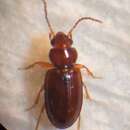Comprehensive Description
provided by Smithsonian Contributions to Zoology
Pericompsus australis (Schaum)
Tachys australis Schaum, 1863:90. [Type (s) not in HUB; not seen. I agree with Darlington’s (1963) logic in regard to the history of this name. Type-locality: Victoria, Australia.]
Tachys monochrous Schaum, 1863:90. [Absolute synonym. Actually, I think Schaum meant his title “Tachys australis” to mean “southern Tachys” as a title of subsequent descriptions. His arrangement, however, must result in synonymy as Darlington (1963:28) points out.]
Tachys flindersi Blackburn, 1888:41. [Lectotype, here selected, a male, in BMNH. Synonymized by Darlington, (1963:28). Type-locality: Port Lincoln, Australia.]
Bembidium tersatum Broun, 1893:1010. [Lectotype, here selected, a female, in BMNH. Synonymized by Darlington (1963:28). Type-locality: Mokohinau Island, New Zealand.]
DESCRIPTION.—Form (Figure 5): Broad and depressed, not subpedunculate as in semistriatus subgroup. Easily distinguished from other Australian Pericompsus members by the pale color, presence of a lateral bead on the pronotum, and the sharp, 90° hind angles of the pronotum.
Color: Shiny rufotestaceous, appendages testaceous.
Head: Across eyes narrower than width of pronotum; frontal furrows shallow, linear, and prolonged only to level of mideye; eyes medium sized and slightly prominent; ocular bulge posterior to eye very sparsely setiferous.
Pronotum (Figure 5): Broadly subcordate, sides moderately sinuate in basal half; base slightly lobed at middle; hind angles about right; side margins beaded, not reflexed disc quite flat, convex at sides; venter sparsely setiferous.
Elytra: Each elytron with 6 or 7 punctate interneurs; punctures medium sized and coarse, separated longitudinally by their own diameter or more; punctures of rows 2–5 effaced posterior of middle, row 6 present or not and represented by 1 or more punctures when present, rows 1 and 8 entire but striate in apical third, interneur 7 effaced externally throughout, lateral channel punctate to basal third, not foveate; humeral margin rounded at base, then slightly concave to level of interneur 4, not connected to base of 4; side margins narrowly explanate, coarsely serrate-setulose to apical fourth, less serrate posterior to middle; setae equal in length to width of elytral explanation; chaetotaxy as in P. semistriatus; plica long but only slightly developed externally.
Abdomen: Sterna III–IV each sparsely setiferous.
Microsculpture: Effaced from dorsal surface.
Genitalia: Male (Figure 12) (1 examined); female characteristic of ephippiatus group (8 examined).
Size: Length, 1.72–2.40 mm; width, 0.72–0.92 mm; 10 specimens measured.
VARIATION.—The punctation of interneur 6 is present or absent, when present it may be represented by 1 to 7 punctures. The two elytra of each beetle vary from each other as well. The punctation of the other interneurs varies also, but at least some punctures are always present.
NATURAL HISTORY.—Specimens were collected in January through April, June, October through December; one specimen labeled “Oct.-Nov.” was teneral. Darlington (1963) records these beetles as occurring “under cover by standing or running water or in other wet places.” Blackburn (1888) recorded his specimens from swampy ground and the banks of the Torrens River. The species is no doubt subhygrophilus.
DISTRIBUTION.—The range of this species extends throughout the eastern half of Australia and extends southward to Tasmania and New Zealand. It is probably introduced into the latter country (Darlington, 1963). An apparent disjunction occurs toward the west as Darlington found one specimen at Wiluna, Western Australia, in 1931 (see Figure 19).
LOCALITY RECORDS (Figure 19).—I have seen 64 specimens from the following localities:
AUSTRALIA: AUSTRALIAN CAPITOL TERRITORY: Cotter Dam (MCZ). NEW SOUTH WALES: Bellangry F St. NW Wauchope (MCZ, USNM); Bogan River south of Nyngan (MCZ, USNM); vicinity of Dubbo (MCZ); vicinity of Sydney (MCZ); marsh, north of Sydney (BMNH). QUEENSLAND: North of Bowen (MCZ, USNM); Cape York, Rocky River (MCZ); Davis Creek, Kuranda Mareeba Road (MCZ); Gladstone to Many Peaks (MCZ); Shipton’s Flat south of Cooktown (MCZ); Townsville (BMNH); vicinity of Mount Molloy (MCZ); by field, north of Yeppon (MCZ). SOUTH AUSTRALIA: Aroona Dam site southwest of Copley (MCZ); Cooper Crossing (MCZ); North Flinders Range, Ilpounda Water (MCZ); Oodnadatta (MCZ); Port Lincoln (BMNH). TASMANIA: Arve River, Har’z National Park (MCZ). VICTORIA: Ferntree Gully (MCZ). WESTERN AUSTRALIA: Wiluna (MCZ).
NEW ZEALAND: Mokohinau Island (BMNH).
- bibliographic citation
- Erwin, Terry L. 1974. "Studies of the subtribe Tachyina (Coleoptera: Carabidae: Bembidiini), Part II: A Revision of the New World-Australian Genus Pericompsus LeConte." Smithsonian Contributions to Zoology. 1-96. https://doi.org/10.5479/si.00810282.162

